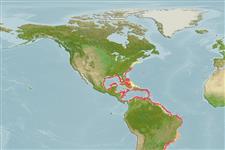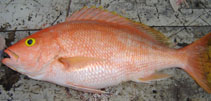Ajouter votre observation dans Fish Watcher
| Native range | All suitable habitat | Point map | Year 2050 |

|
| This map was computer-generated and has not yet been reviewed. |
| Lutjanus vivanus AquaMaps Data sources: GBIF OBIS |
Envoyez vos Photos et vidéos
Pictures | Images GoogleLutjanus vivanus
Picture by Bryan, D.
Pictures | Images GoogleLutjanus vivanus
Picture by Bryan, D.
Puerto Rico country information
Common names:
Chillo, Colorado, Silk snapper
Occurrence: native
Salinity: marine
Abundance: | Ref:
Importance: | Ref:
Aquaculture: | Ref:
Regulations: | Ref:
Uses: no uses
Comments: Also Ref. 50307.
National Checklist:
Country Information: https://www.cia.gov/library/publications/resources/the-world-factbook/geos/rq.html
National Fisheries Authority:
Occurrences: Occurrences Point map
Main Ref: Allen, G.R., 1985
National Database:
Occurrence: native
Salinity: marine
Abundance: | Ref:
Importance: | Ref:
Aquaculture: | Ref:
Regulations: | Ref:
Uses: no uses
Comments: Also Ref. 50307.
National Checklist:
Country Information: https://www.cia.gov/library/publications/resources/the-world-factbook/geos/rq.html
National Fisheries Authority:
Occurrences: Occurrences Point map
Main Ref: Allen, G.R., 1985
National Database:
Common names from other countries
Classification / Names Noms communs | Synonymes | Catalog of Fishes(Genre, Espèce) | ITIS | CoL | WoRMS | Cloffa
> Eupercaria/misc (Various families in series Eupercaria) > Lutjanidae (Snappers) > Lutjaninae
Etymology: Lutjanus: Malay, ikan lutjan, name of a fish.
More on author: Cuvier.
Etymology: Lutjanus: Malay, ikan lutjan, name of a fish.
More on author: Cuvier.
Environment: milieu / climate zone / depth range / distribution range Écologie
marin récifal; profondeur 90 - 242 m, usually 90 - 140 m (Ref. 55). Subtropical; 41°N - 30°S, 99°W - 32°W (Ref. 55)
Distribution Pays | Zones FAO | Écosystèmes | Occurrences | Point map | Introductions | Faunafri
Western Atlantic: North Carolina, USA and Bermuda to São Paulo, Brazil (Ref. 57756). Most abundant around the Antilles and the Bahamas.
Length at first maturity / Taille / Poids / Âge
Maturity: Lm 41.6, range 24 - 26 cm
Max length : 83.0 cm TL mâle / non sexé; (Ref. 40637); common length : 45.0 cm TL mâle / non sexé; (Ref. 55); poids max. publié: 8.3 kg (Ref. 4699)
Max length : 83.0 cm TL mâle / non sexé; (Ref. 40637); common length : 45.0 cm TL mâle / non sexé; (Ref. 55); poids max. publié: 8.3 kg (Ref. 4699)
Description synthétique Clés d'identification | Morphologie | Morphométrie
Épines dorsales (Total) : 10 - 11; Rayons mous dorsaux (Total) : 13 - 14; Épines anales: 3; Rayons mous anaux: 7 - 8. Preopercular notch and knob weak. Pectoral fins long reaching level of anus. Scale rows on back rising obliquely above lateral line. Back and upper sides pink to red, grading to pink with a silvery sheen ventrally; sides with very fine undulating yellow lines; the fins mostly reddish or pale yellow. Young specimens (under about 25 cm) with a blackish spot on upper side below anterior dorsal soft rays.
Adults are common near the edge of the continental and island shelves; also found in deeper waters (below 200 m); usually ascending to shallow water at night. They feed mainly on fishes, shrimps, crabs, gastropods, cephalopods, tunicates and some pelagic items including urochordates. Marketed fresh. Said to be a good food fish (Ref. 5521).
Life cycle and mating behavior Maturité | Reproduction | Frai | Œufs | Fécondité | Larves
Spawning occurs over most of the year in lower latitudes, but is seasonal (spring and summer) toward the northern and southern limits of the distribution.
Référence principale
Upload your references | Références | Coordinateur | Collaborateurs
Allen, G.R., 1985. FAO Species Catalogue. Vol. 6. Snappers of the world. An annotated and illustrated catalogue of lutjanid species known to date. FAO Fish. Synop. 125(6):208 p. Rome: FAO. (Ref. 55)
Statut dans la liste rouge de l'IUCN (Ref. 130435: Version 2024-2)
Préoccupation mineure (LC) ; Date assessed: 10 October 2015
Utilisations par l'homme
Pêcheries: commercial; pêche sportive: oui
FAO(pêcheries: production; publication : search) | FishSource | Sea Around Us
Plus d'informations
Trophic ecology
Éléments du régime alimentaire
Composition du régime alimentaire
Consommation alimentaire
Food rations
Prédateurs
Éléments du régime alimentaire
Composition du régime alimentaire
Consommation alimentaire
Food rations
Prédateurs
Population dynamics
Paramètres de croissance
Max. ages / sizes
Length-weight rel.
Length-length rel.
Fréquences de longueurs
Mass conversion
Recrutement
Abondance
Paramètres de croissance
Max. ages / sizes
Length-weight rel.
Length-length rel.
Fréquences de longueurs
Mass conversion
Recrutement
Abondance
Life cycle
Reproduction
Maturité
Fécondité
Frai
Spawning aggregations
Œufs
Développement de l'œuf
Larves
Dynamique des populations larvaires
Reproduction
Maturité
Fécondité
Frai
Spawning aggregations
Œufs
Développement de l'œuf
Larves
Dynamique des populations larvaires
Anatomy
Surface branchiale
Brain
Otolith
Surface branchiale
Brain
Otolith
Physiology
Body composition
Nutrients
Consommation d'oxygène
Type de nage
Vitesse de nage
Visual pigments
Fish sound
Diseases & Parasites
Toxicity (LC50s)
Body composition
Nutrients
Consommation d'oxygène
Type de nage
Vitesse de nage
Visual pigments
Fish sound
Diseases & Parasites
Toxicity (LC50s)
Genetics
Génétique
Heterozygosity
Héritabilité
Génétique
Heterozygosity
Héritabilité
Human related
Aquaculture systems
Profils d'aquaculture
Souches
Ciguatera cases
Stamps, coins, misc.
Aquaculture systems
Profils d'aquaculture
Souches
Ciguatera cases
Stamps, coins, misc.
Outils
E-book | Guide de terrain | Clés d'identification | Générateur de fréquences de longueur | Outil de dynamique de population | Carte par point | Classification Tree
| Catch-MSY |
Articles particuliers
Télécharger en XML
Sources Internet
Aquatic Commons | BHL | Cloffa | Websites from users | FishWatcher | CISTI | Catalog of Fishes(Genre, Espèce) | DiscoverLife | ECOTOX | Faunafri | Fishtrace | GenBank(génôme, nucléotide) | GloBI | GOBASE | | Google Books | Google Scholar | Google | IGFA World Record | MitoFish | Bases de données nationales | Otolith Atlas of Taiwan Fishes | PubMed | Reef Life Survey | Identification RFE | Scirus | SeaLifeBase | Arbre de Vie | Wikipedia(aller à, chercher) | World Records Freshwater Fishing | Zoological Record
Estimates based on models
Preferred temperature (Ref. 115969): 17.3 - 25.2, mean 21.2 (based on 73 cells).
Phylogenetic diversity index (Ref. 82804): PD50 = 0.5000 [Uniqueness, from 0.5 = low to 2.0 = high].
Bayesian length-weight: a=0.01479 (0.01303 - 0.01679), b=2.97 (2.95 - 2.99), in cm Total Length, based on LWR estimates for this species (Ref. 93245).
Niveau trophique (Ref. 69278): 3.1 ±0.5 se; based on diet studies.
Résilience (Ref. 120179): Faible, temps minimum de doublement de population : 4,5 à 14 années (K=0.09-0.32; tm=5).
Prior r = 0.28, 95% CL = 0.19 - 0.43, Based on 2 data-limited stock assessments.
Fishing Vulnerability (Ref. 59153): Moderate vulnerability (37 of 100).




